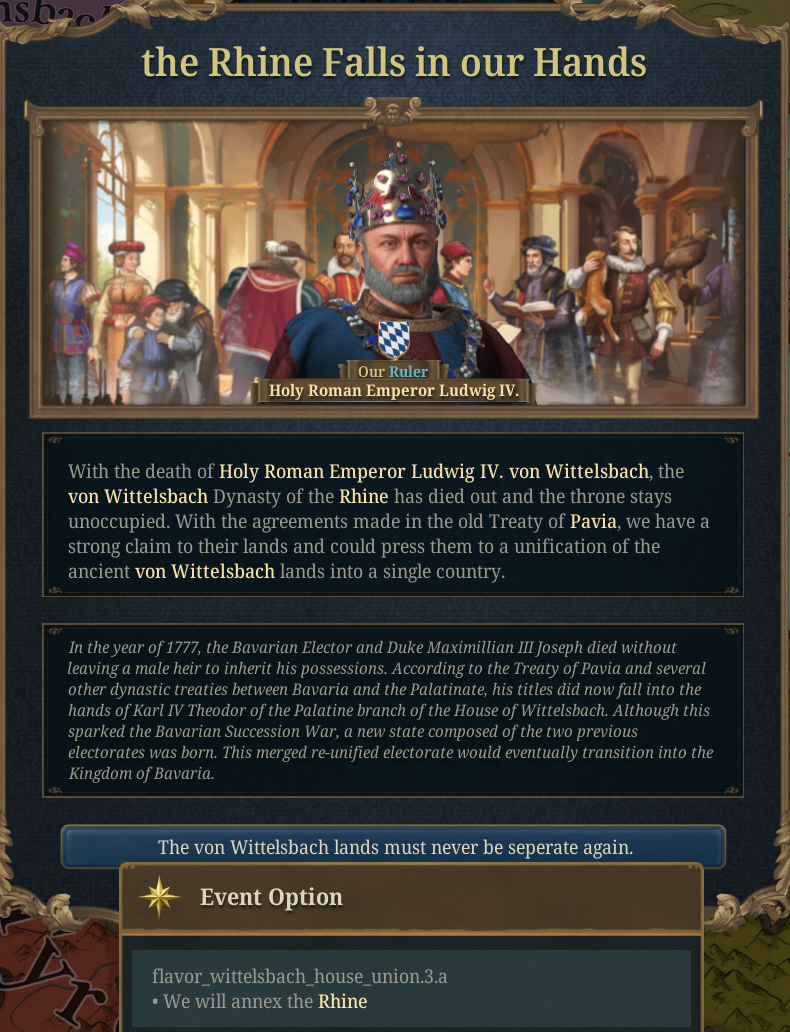Hello, and welcome one more week to Tinto Flavour, the happy Fridays in which we take a look at the flavourish content of the new, super-secret Project Caesar.
Today we will be taking a look at Bavaria. Or, to be more precise, at the Duchies of Upper Bavaria and Lower Bavaria, as the Wittelsbach divided their lands among different branches; in addition to these two, the Treaty of Pavia (1329) also established the lands of the Electorate of the Palatinate of the Rhine (best known as The Palatinate) to be ruled by a third Wittelsbach branch.

You might have noticed that the courtroom is different from other European rulers we’ve shown previously; this is the Throne of Charlemagne, part of the Palatine Chapel in Aachen, used in the coronation of Holy Roman Emperors; thus, is the one used by these rulers. We’d like to eventually keep adding some more unique art, such as the Imperial Crown; but, as usual, please take the UI, 2D and 3D art as WIP.
Here you have the core lands of Bavaria, divided among Upper Bavaria, Lower Bavaria, and the Palatinate:

Don't you love how Bavarians decided to split their lands into multiple polities?
The position of the Wittelsbach is quite strong, as Emperor Ludwig’s son, also named Ludwig, rules over the Electorate of Brandenburg, thus making the dynasty control 2 out of the 7 Imperial Electorates effectively:

Here you can see the lands controlled by the Wittelsbach dynasty, and also their two main rivals for the Imperial Crown, the Luxembourg and Habsburg dynasties.
One of the main objectives for any of the branches of the Wittelsbach dynasty will be to unite these lands, and create/recreate the Kingdom of Bavaria, one of the formable countries that we presented in last week’s Tinto Talks:

You might have noticed that we fixed the starting country of Bavaria, and now is Tier III, which is the Kingdom rank.
Let’s start today with the narrative content, namely events, linked to the aforementioned dynastic issues. Early in the game, if the Duke of Lower Bavaria dies of his leprosy, leaving an underage ruler, you might receive this event:

The first option makes Lower Bavaria a vassal, the second directly annexes it, and the third leaves the Duchy on its own.
If you select either the first or the second option, a follow-up event about the revision of the Treaty of Pavia may trigger:

I promise this treaty is historical, and it's not related to my vanity!
If we select the second option, this may happen:

Wittelsbach lands are reunited! We need to do some fixes for the dynamic localization of the Palatinate of the Rhine to appear properly in all instances, by the way.
Leading to this outcome:

The Kingdom of Bavaria is recreated!
And you will also get this another event, as you may decide to change your succession law at this moment:

Cognatic Primogeniture sounds like a more stable law, indeed.
Besides the Wittelsbach dynastical troubles, other Bavarian dynamic historical events that may be of interest:

Ockham’s Razor in action!


What about a new Code of Laws?
This is an interesting set of events. If the player decides to build the Munich Residenz, a unique building will be constructed, also opening the option to get further expansions:




Let’s now move towards the structural content of Bavaria. German countries start with this privilege for the nobility, coupled with their succession law:

Bavaria also has a policy that portrays its itinerant court:

As the Holy Roman Emperor, Ludwig starts in possession of some unique works of art, the Imperial Regalia:




Bavaria also starts with this local work of art:

Which may be expanded via an event:

Finally, some Bavarian advances, covering from the Age of Traditions to the Age of Revolutions:




However my favourite is this one:

That unlocks this production method:

Which you can compare with the other PMs for Breweries:

And that’s all for today! I hope you enjoyed it! Next week we will be travelling back to the Mediterranean shores, to the land of Morocco. Cheers!
Today we will be taking a look at Bavaria. Or, to be more precise, at the Duchies of Upper Bavaria and Lower Bavaria, as the Wittelsbach divided their lands among different branches; in addition to these two, the Treaty of Pavia (1329) also established the lands of the Electorate of the Palatinate of the Rhine (best known as The Palatinate) to be ruled by a third Wittelsbach branch.

You might have noticed that the courtroom is different from other European rulers we’ve shown previously; this is the Throne of Charlemagne, part of the Palatine Chapel in Aachen, used in the coronation of Holy Roman Emperors; thus, is the one used by these rulers. We’d like to eventually keep adding some more unique art, such as the Imperial Crown; but, as usual, please take the UI, 2D and 3D art as WIP.
Here you have the core lands of Bavaria, divided among Upper Bavaria, Lower Bavaria, and the Palatinate:

Don't you love how Bavarians decided to split their lands into multiple polities?
The position of the Wittelsbach is quite strong, as Emperor Ludwig’s son, also named Ludwig, rules over the Electorate of Brandenburg, thus making the dynasty control 2 out of the 7 Imperial Electorates effectively:

Here you can see the lands controlled by the Wittelsbach dynasty, and also their two main rivals for the Imperial Crown, the Luxembourg and Habsburg dynasties.
One of the main objectives for any of the branches of the Wittelsbach dynasty will be to unite these lands, and create/recreate the Kingdom of Bavaria, one of the formable countries that we presented in last week’s Tinto Talks:

You might have noticed that we fixed the starting country of Bavaria, and now is Tier III, which is the Kingdom rank.
Let’s start today with the narrative content, namely events, linked to the aforementioned dynastic issues. Early in the game, if the Duke of Lower Bavaria dies of his leprosy, leaving an underage ruler, you might receive this event:

The first option makes Lower Bavaria a vassal, the second directly annexes it, and the third leaves the Duchy on its own.
If you select either the first or the second option, a follow-up event about the revision of the Treaty of Pavia may trigger:

I promise this treaty is historical, and it's not related to my vanity!
If we select the second option, this may happen:

Wittelsbach lands are reunited! We need to do some fixes for the dynamic localization of the Palatinate of the Rhine to appear properly in all instances, by the way.
Leading to this outcome:

The Kingdom of Bavaria is recreated!
And you will also get this another event, as you may decide to change your succession law at this moment:

Cognatic Primogeniture sounds like a more stable law, indeed.
Besides the Wittelsbach dynastical troubles, other Bavarian dynamic historical events that may be of interest:

Ockham’s Razor in action!


What about a new Code of Laws?
This is an interesting set of events. If the player decides to build the Munich Residenz, a unique building will be constructed, also opening the option to get further expansions:




Let’s now move towards the structural content of Bavaria. German countries start with this privilege for the nobility, coupled with their succession law:

Bavaria also has a policy that portrays its itinerant court:

As the Holy Roman Emperor, Ludwig starts in possession of some unique works of art, the Imperial Regalia:




Bavaria also starts with this local work of art:

Which may be expanded via an event:

Finally, some Bavarian advances, covering from the Age of Traditions to the Age of Revolutions:




However my favourite is this one:

That unlocks this production method:

Which you can compare with the other PMs for Breweries:

And that’s all for today! I hope you enjoyed it! Next week we will be travelling back to the Mediterranean shores, to the land of Morocco. Cheers!








